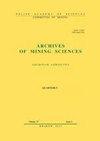Modelling of Limestone Calcination for Optimisation of Parallel Flow Regenerative Shaft Kiln (PFR), Case Study: Iran Alumina Plant
IF 1.2
4区 工程技术
Q3 MINING & MINERAL PROCESSING
引用次数: 4
Abstract
to produce the lime required for the bayer process, two parallel flow regenerative shaft kilns (pFr) were used in the iran Alumina plant located in Jajarm, north Khorasan province, iran. in this study, the calcination conditions of limestone were modelled in a laboratory furnace by considering three factors of limestone size, temperature and calcination time using the box-behnken method. the calcination model of limestone was obtained using a quadratic equation. due to the importance of limestone dust in the performance of industrial kilns, conditions of calcification and its reactivity with water were examined at three temperature ranges of 800, 1000, and 1200°C, by two methods of titration and standard AStM C110. the results indicated a decrease in reactivity of lime relative to the increased temperature of calcination and the lack of forming the burnt lime particles that stick together (blocking). Finally, the ratio of input limestone (kg) to fuel (m 3 ) was reduced from 16.4 to 15.3 to increase the average temperature of the burning zone to 1000°C. Also, excess air was reduced from 40 to 20%. in this condition, the lime quality was increased by about 6% in the kilns.优化并流再生竖窑(PFR)的石灰石煅烧建模,案例研究:伊朗氧化铝厂
为了生产拜耳法所需的石灰,位于伊朗呼罗珊省北部贾贾尔姆的伊朗氧化铝厂使用了两个平行流再生竖窑(pFr)。在本研究中,采用box-behnken方法,通过考虑石灰石尺寸、温度和煅烧时间三个因素,在实验室熔炉中模拟了石灰石的煅烧条件。利用二次方程建立了石灰石煅烧模型。由于石灰石粉尘在工业窑炉性能中的重要性,在800、1000和1200°C的三个温度范围内,通过两种滴定法和标准AStM C110检测了钙化条件及其与水的反应性。结果表明,相对于煅烧温度的升高,石灰的反应性降低,并且没有形成粘在一起的煅烧石灰颗粒(堵塞)。最后,输入石灰石(kg)与燃料(m3)的比例从16.4降低到15.3,以将燃烧区的平均温度提高到1000°C。此外,过量空气从40%减少到20%。在这种条件下,窑内石灰的质量提高了6%左右。
本文章由计算机程序翻译,如有差异,请以英文原文为准。
求助全文
约1分钟内获得全文
求助全文
来源期刊

Archives of Mining Sciences
工程技术-矿业与矿物加工
CiteScore
2.40
自引率
16.70%
发文量
0
审稿时长
20 months
期刊介绍:
Archives of Mining Sciences (AMS) is concerned with original research, new developments and case studies in mining sciences and energy, civil engineering and environmental engineering. The journal provides an international forum for the publication of high quality research results in:
mining technologies,
mineral processing,
stability of mine workings,
mining machine science,
ventilation systems,
rock mechanics,
termodynamics,
underground storage of oil and gas,
mining and engineering geology,
geotechnical engineering,
tunnelling,
design and construction of tunnels,
design and construction on mining areas,
mining geodesy,
environmental protection in mining,
revitalisation of postindustrial areas.
Papers are welcomed on all relevant topics and especially on theoretical developments, analytical methods, numerical methods, rock testing, site investigation, and case studies.
 求助内容:
求助内容: 应助结果提醒方式:
应助结果提醒方式:


